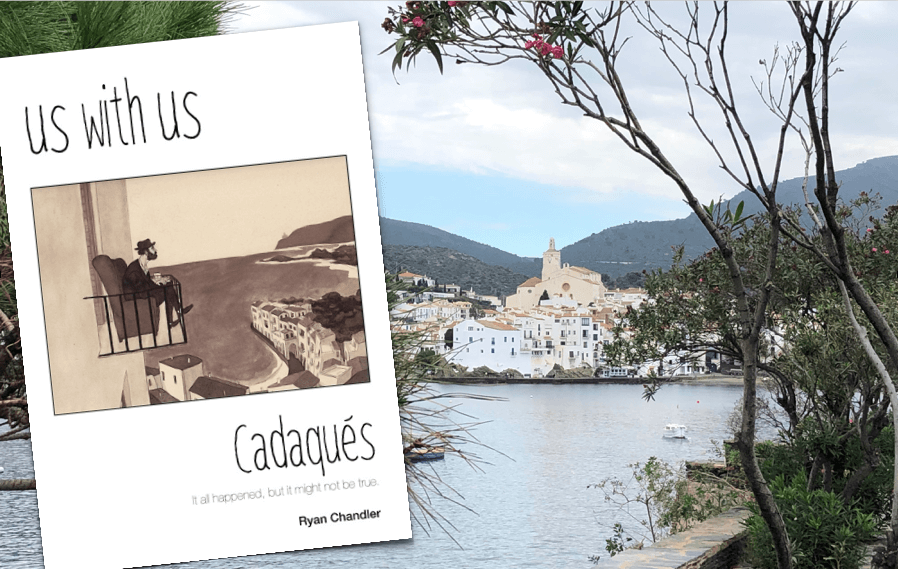This is a book about the town of Cadaqués, best known nowadays for the house-museum of Salvador Dalí, who lived and worked in the adjacent Portlligat from the early 1930s for some 40 years, attracting many famous visitors.
It is an account of the better part of a year spent in a flat right on the seafront by this long-time Barcelona-based British writer, Ryan Chandler, and his Catalan wife. Shortly after the October 2017 referendum, they escaped the ensuing storm and tensions for this very beautiful, distinctive and still somewhat isolated place near the top of the Costa Brava.
Chandler speaks good Catalan and is obviously well adjusted to life here – important to note given the view he presents of Cadasequencs as essentially a closed-off, hermetic bunch, despite having tolerated a long series of bohemians, hippies and other eccentrics in their midst: ‘These funky outsiders are now so much a part of what the place has become. And yet, they’re not.’
You may go there, even move in there, but this era of mass tourism has still not entirely broken through the age-old hermeticism and cronyism of the local inhabitants.
Chandler is a sensitive, empathetic observer, explorer and participant in the life of the town. He modestly calls the book ‘a scrapbook-diary’; it is both and much more.
It consists of short chapters on many themes – from a history of the area to vivid descriptions of particular corners in and around the town, to local characters present and past, a day in the life of the writer, funny or frustrating incidents, musings and magical moments, plus useful and amusing snippets on local restaurants and bars, a few poems, and some funny little virtual chats.
Besides, he lightly weaves in the emotions of the moment in Catalonia and briefly notes the days of imprisonment of Jordi Cuixart in the so-called procès. But the book is not at all sloppy. The writing is lively, smooth and witty, and every little piece enhances your sense of the place.
You end up with a clear, personalised but very well-informed view of the town and its inhabitants, and how it and they came to be as they are. You will also find the striking illustrations by Cadaqués artist Javier Aznarez, which in themselves are enough to make me want to return and find more of his work.
This year-long sojourn stretches from winter to winter, with much coming and going. We see the changes, as much is closed in the winter months and the fierce Tramuntana wind may blow, while in July and August the population multiplies tenfold, traffic jams form on the road over the mountains and there is no parking left in the town, so some cars actually have to turn back.
Until the late 1800s Cadaqués was only accessible by sea, and even today that one short road has such tight hairpin turns and steep drops that it is not to be used lightly. The twisting road, along with the ‘mad bus driver’ (who is both angry and wacky), play a major role throughout the book.
The town has been through centuries of raids by pirates, several unavoidably sweeping transformations in its economy, and a period of major emigration to the Americas, from which some returned to flaunt and invest their wealth in the town, as did those so-called Americanos in other places around Spain, like Sitges. Due to its long isolation, it has kept its own distinct dialect of Catalan, and that ‘us with us’ or ‘nos amb nos’ mentality to a large extent.
The reader will discover along with Chandler why Cadaqués has long attracted artists and eccentrics, and the role that the surreal landscape of adjacent Cap de Creus, where the Pyrenees tumble into the sea, played in the development of Dalí’s art and in the attraction of the place.
The relative isolation, the winds of the ‘Wild Coast’, the nearby mountains left bare since a plague killed off the vineyards that once rose on the stone terraces, the white village itself whose steep slate streets clamber up the hillside to the church and reach right down to wrap around the inlet where the tall houses practically plunge into the sea, the astonishing landscape of Cap de Creus with its slate shapes moulded by wind and weather, and the sheltered location and orientation that make for long dawns and twilights, all combine – perhaps with other, mysterious tectonic forces – to make for a very special place. It’s all there in ‘Us with Us’ – a vivid and witty read.
‘Us with Us – Cadaqués. It all happened but it might not be true’ by Ryan Chandler. Published by Barcelona INK Books.
If you would like to write a review of a specific book related to Spain, please email: editorial@spainenglish.com
Sign up for the FREE Weekly Newsletter from Spain in English.
Please support Spain in English with a donation.
Click here to get your business activity or services listed on our DIRECTORY.
Click here for further details on how to ADVERTISE with us.


